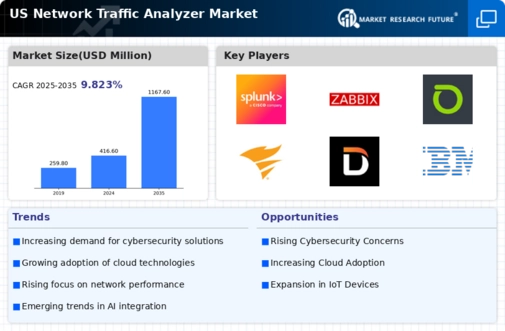Growth of Cloud Computing
The proliferation of cloud computing services is significantly influencing the network traffic-analyzer market. As businesses increasingly migrate their operations to the cloud, the complexity of network traffic management escalates. In 2025, the cloud services market is projected to reach $832 billion, necessitating effective tools to monitor and analyze traffic across diverse cloud environments. Network traffic analyzers play a crucial role in ensuring optimal performance and security in cloud-based infrastructures. They provide insights into data flow, application performance, and potential vulnerabilities. This trend is particularly relevant for organizations adopting hybrid or multi-cloud strategies, as they require comprehensive visibility into their network traffic. Thus, the growth of cloud computing is expected to propel the demand for advanced network traffic-analyzer solutions.
Shift Towards Remote Work
The shift towards remote work is reshaping the landscape of the network traffic-analyzer market. As organizations adopt flexible work arrangements, the need for secure and efficient network management becomes paramount. In 2025, it is estimated that over 30% of the US workforce will be working remotely, leading to increased reliance on virtual private networks (VPNs) and cloud services. This shift necessitates robust network traffic analysis tools to monitor and secure remote connections, ensuring that sensitive data remains protected. Additionally, organizations must manage the performance of applications accessed remotely, which can be challenging without effective monitoring solutions. As a result, the demand for network traffic-analyzer tools that cater to the needs of remote work environments is likely to grow, driving innovation and investment in this sector.
Rising Cybersecurity Threats
The network traffic-analyzer market is experiencing growth due to the increasing frequency and sophistication of cybersecurity threats. Organizations are compelled to invest in advanced network traffic analysis tools to detect and mitigate potential breaches. In 2025, it is estimated that cybercrime will cost businesses globally over $10 trillion annually, prompting a heightened focus on security measures. The need for real-time monitoring and analysis of network traffic is paramount, as it enables organizations to identify anomalies and respond swiftly to threats. This trend is particularly pronounced in sectors such as finance and healthcare, where sensitive data is at risk. Consequently, the demand for robust network traffic-analyzer solutions is likely to surge, driving innovation and competition within the market.
Regulatory Compliance Requirements
The network traffic-analyzer market is being driven by stringent regulatory compliance requirements across various industries. Organizations are mandated to adhere to regulations such as GDPR and HIPAA, which necessitate the monitoring and protection of sensitive data. In 2025, compliance-related spending is anticipated to exceed $20 billion in the US alone, highlighting the critical need for effective network traffic analysis tools. These tools assist organizations in ensuring that their data handling practices align with regulatory standards, thereby mitigating the risk of costly fines and reputational damage. As compliance becomes increasingly complex, the demand for sophisticated network traffic-analyzer solutions that can provide detailed reporting and auditing capabilities is likely to rise, further fueling market growth.
Increased Internet of Things (IoT) Adoption
The rapid adoption of Internet of Things (IoT) devices is significantly impacting the network traffic-analyzer market. As more devices connect to networks, the volume and complexity of data traffic increase, necessitating advanced analysis tools. In 2025, it is projected that there will be over 30 billion connected IoT devices worldwide, creating challenges for network management and security. Network traffic analyzers are essential for monitoring the performance and security of these devices, ensuring that they do not become entry points for cyber threats. This trend is particularly relevant in sectors such as manufacturing and smart cities, where IoT applications are proliferating. Consequently, the growth of IoT is expected to drive demand for innovative network traffic-analyzer solutions that can handle the unique challenges posed by this expanding ecosystem.





















Leave a Comment